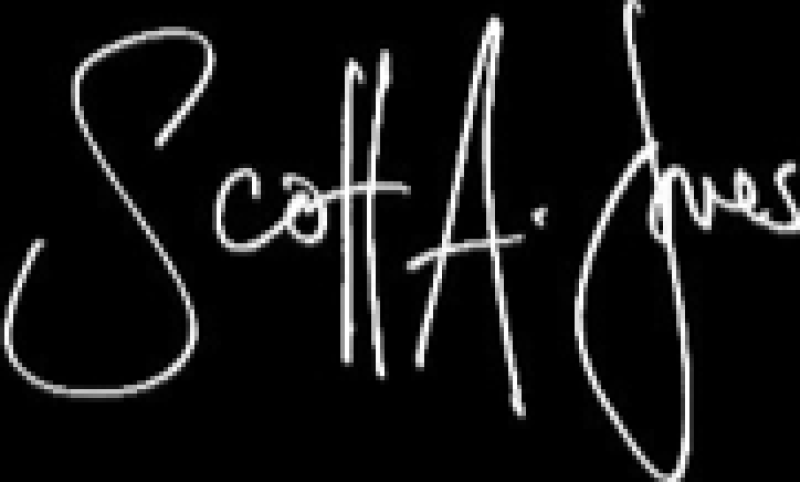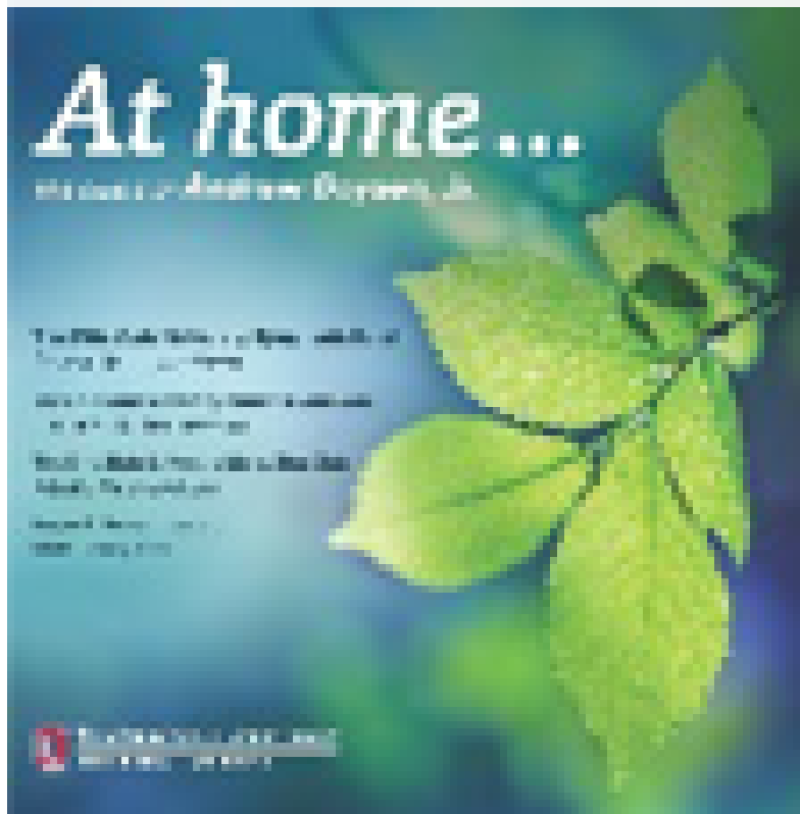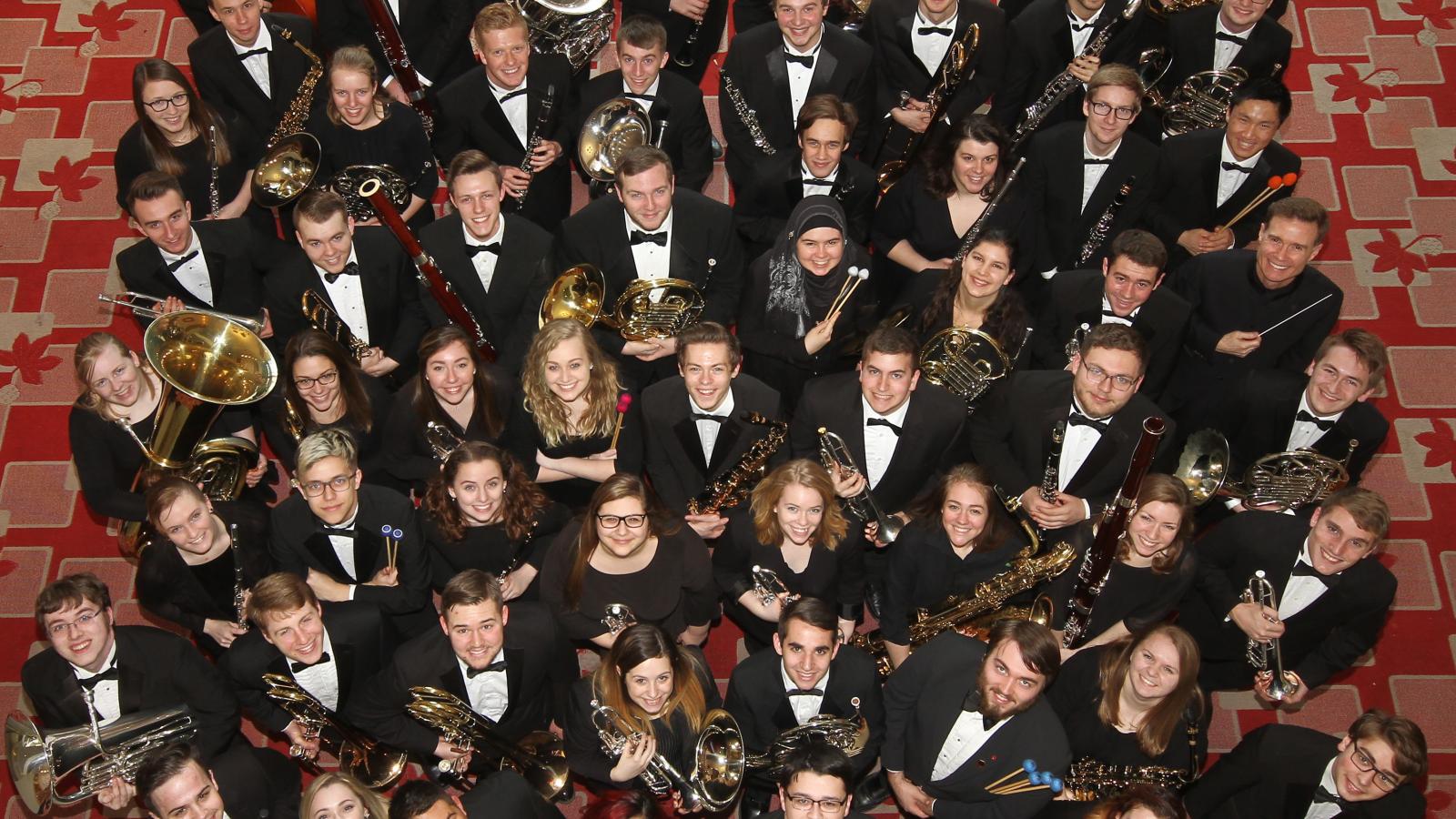Thursday, April 4, 2019
7:30 p.m.
Gahanna Lincoln High School Auditorium
GAHANNA LINCOLN HIGH SCHOOL GOLD BAND
Rob Cebriak, conductor
Scott A. Jones, conductor
WELCOME
Thank you for joining us for this special concert featuring the musicians of the Gahanna Lincoln High School Gold Band and the Ohio State Symphonic Band. The Ohio State School of Music has enjoyed a meaningful connection with the community of Gahanna through its teachers, students, families and collaborations for decades. This evening’s performance serves to celebrate that rich history…as well as my personal friendships with all of the Gahanna Band faculty.
The evening will begin with two compositions performed by the Gahanna Lincoln HS Gold Band. The first of two Karl King marches that you will hear this evening is his 1945 composition "The Trombone King" which — true to its name — provides an enjoyable part for the musicians of that instrument section. The first two movements of Francis McBeth's music suite based upon Melville's Moby Dick will bring this first part of our concert to a close.
The first work performed by the Ohio State Symphonic Band is a new edition of a march by Karl King by the School of Music’s own faculty member Alan Green. This composition, along with works of many others, came into public domain on January 1, 2019. Celebrated as “Public Domain Day,” 2019 is significant because “it marks the first time in many years that works first registered or published in the U.S. entered the public domain in the U.S. due to expiration of their copyright term.” We celebrate that event, this new edition, and remembering Ohio’s own Karl King with this march he dedicated to the Grand Army Band of Canton, Ohio.
The march will be performed without conductor, as it was prepared and rehearsed. This collaborative approach to ensemble music making was inspired by the Orpheus Chamber Orchestra, an internationally renowned ensemble that has been making music without conductor for nearly 50 years.
The final composition performed by our Ohio State musicians is a premiere of a 31-minute symphony for band by American composer Timothy Mahr. The Ohio State Symphonic Band was a member of the consortium to commission this composition, and we have found it to be a remarkable composition — one that makes an important contribution to the repertory of the concert band. You will find great reward in reading the extensive program note below from the composer.
Concluding the evening will be two compositions performed by the combined musicians of the Gahanna Lincoln Gold Band and the Ohio State Symphonic Band. We are deeply looking forward to making music together as our evening comes to an end.
Thank you to all who welcomed us today and made this collaboration possible at Gahanna Lincoln High School. Enjoy the performance!

PROGRAM
The Trombone King (1945)
Karl L. King (1891–1971)
arr. Paynter
Born in Paintersville, OH, Karl King would come to be known as one of the most prolific and popular figures in band history. His compositional catalog includes 185 marches, 22 overtures, 12 galops, 29 waltzes, and works in many other styles. He spent the last 50 years of his life in Fort Dodge, Iowa, where the “Karl L. King Municipal Band” continues to perform concerts for the public.
Of Sailors and Whales (1990)
W. Francis McBeth (1933–2012)
1. Ishmael
2. Queequeg
Francis McBeth was raised in Texas and began studying trumpet in the second grade. As a high school student he lettered in football and track and was in the band and choir programs. He taught at Ouachita University in Arkansas from 1957 until 1996 and was well-regarded for his pedagogical ideas and award-winning compositions. Some of his most notable works for band include Chant and Jubilo (1961), Masque (1967), The Seventh Seal (1972), Kaddish (1975), Canto (1977), They Hung Their Harps in the Willows (1988), and Through Countless Halls of Air (1993).
Of Sailors and Whales is a five-movement work based on scenes from Herman Melville’s Moby Dick. The Gold Band will be performing the first two of these movements. McBeth invites the audience to reflect on the following quotes, loosely adapted from the novel, for each of the movements:
1. Ishmael
“Call me Ishmael. I go to sea as a simple sailor, right before the mast, plumb down into the forecastle, aloft there to the royal masthead. I am tormented with an everlasting itch for things remote. I love to sail forbidden seas and land on barbarous coasts. For these reasons, the whaling voyage was welcome; the great floodgates of the wonder-world swung open. There floated in my inmost soul endless processions of the whale, and one grand, hooded phantom — like a snow hill in the sky.”
At the top of the parts and score of the first movement, McBeth includes the quote, “I go to sea as a simple sailor.” As a wonderful pun, the first 26 measures of the piece are in C (sea) Major!
2. Queequeg
“Queequeg’s father was a High Chief, a King; his uncle, a High Priest. There was excellent blood in his veins — royal stuff. It was quite plain that he must be some abominable savage, but Queequeg was a creature in the transitory state — neither caterpillar nor butterfly. Savage though he was, and hideously marred about the face, his countenance yet had something in it; through all his unearthly tattooings, and in his large, deep eyes, fiery black and bold, there seemed tokens of a spirit that would dare a thousand devils.”
McKinley’s Own (1923)
Karl L. King (1891–1971)
ed. Green, arr. Jones and Levesque
Among the nearly three hundred band compositions by Ohioan Karl L. King is the march "McKinley’s Own." The title refers to Canton’s Grand Army of the Republic Band, which King served as conductor in 1919. Published in 1923 by Fillmore in Cincinnati, the march was dedicated by King to his predecessor Emil Reinkendorf and the band, which had performed at gubernatorial and presidential campaign appearances by Canton native William McKinley in the 1890s. This performance marks the centennial of King’s directorship of the Grand Army Band.
— Note by Alan Green
Symphony No. 1
Timothy Mahr (b. 1956)
Commissioning Consortium Premiere
1. E Pluribus Unum
—“out of many, one”
2. “… to give up every favorite pursuit and lay their shoulder to the work of the day.”
— Thomas Jefferson
3. “I thank my God upon every remembrance of you.”
— Philippians 1:3, King James Version
4. “only in the darkness can you see the stars.”
— Martin Luther King, Jr.
A professor of music at St. Olaf College, Dr. Timothy Mahr conducts the St. Olaf Band, and has taught courses in composition, music education, and conducting. His compositions have been performed worldwide, recorded, and broadcast. He received the 1991 ABA/Ostwald Award for his work The Soaring Hawk.
“My Symphony No.1, commissioned by a consortium of 54 ensembles and premiered in 2016, is comprised of four movements. The first grew from pondering the challenge our nation and world have to come together rather than grow apart; the second is an acknowledgement of the need to focus on work that truly needs to be done; the third is a reverent appreciation of the love, respect and joy to be found in others; and the last embodies hope, finding light within the darkness.
Each movement sprang from contemplating a specific phrase or quotation while searching for the music to capture these four sentiments.
I. E Pluribus Unum — “out of many, one” — Once the motto of the United States.
An introduction presents fragments of the principal musical ideas to be developed throughout the work, after which a main theme is stated. It becomes one of many as it goes through manipulations and variations. Much of the music is based on an overtone scale based on the keynote of F (an overtone scale is marked by a raised 4th and lowered 7th scale degree — F-G-A-B-C-D-E flat-F). These lead to a culminating unified statement that is strong and defiant.
II. “…to give up every favorite pursuit and lay their shoulder to the work of the day.” — Thomas Jefferson, in an 1803 letter to John Page, former classmate and governor of Virginia, describing the efforts made by the revolutionists who formed our democracy
Solos for flute and clarinet languish in a peaceful melancholy during the opening — the introspective, calm joy of a favorite pursuit. A pressing moment of realization inspires action and an energetic scherzo that derives its melodies and harmonies from the overtone scale ensues. Murky resistance and disorientation are encountered as the path forward is pursued. This is a busy music — it is about work being done. A moment of doubt creeps in, after which the determined hard work continues. A coda pushes the ending toward an agitated climax. Our work is not yet done — much more effort is needed.
III. “I thank my God upon every remembrance of you.” — Paul, writing to the early Greek Christians in Philippi. Philippians 1:3 King James Version
The third movement brings the listener to a welcome place – calm and unhurried, with dissonance at bay. In this turbulent, confusing world, comfort and solace can be found within the close relationships with friends and our reflections upon shared experiences. How grateful we should be for those lovely sustaining memories. An emotional wave of joy and appreciation washes over. More memories return before the movement ends in light.
IV. “Only in the darkness can you see the stars.” — Martin Luther King, Jr.
This is a common paraphrase of a statement King made in his famous “I’ve been to the mountaintop” speech of April 3, 1968. He said, “Only when it’s dark enough can you see the stars.”
"Lovely memories can sustain us, but we often rest uneasy under the burden of others. There is indeed a troubling darkness in this world. As Martin Luther King, Jr. reminds us, the stars, perhaps representing hope, can be perceived from within this blackened depth. A salvation — a darkness-conquering light — can arrive as bursts of energy or gentle, all-encompassing washes to once again bring inner peace.
The project was formulated and implemented by Matthew Dehnel, Director of Bands at Roseville Area High School in Roseville, Minnesota. The work was premiered on November 17, 2016 with Maestro Dehnel leading the Roseville Area High School Symphonic Band. It is dedicated to my family, who sustain me with their love and encouragement.”
Salvation is Created (1912/1957)
Pavel Tschesnokoff (1877–1944), ed. Houseknecht
Pavel Tschesnokoff was a renowned Russian sacred choral composer and conductor. He was educated at the Moscow Conservatory and eventually joined the faculty at the institution, founding its choral conducting program. He composed more than 500 choral works, of which nearly 400 are sacred.
Originally scored for as a six-voice choral composition and the fifth of his Ten Communion Hymns, Op. 25, this composition was never heard by the composer during his lifetime. It served as one of his final sacred compositions before turning to secular music as the Soviet government began to suppress Christianity. The setting is very simple - two almost identical verses that only vary in their final harmonic cadences.
Sounds from the Oval (2018)
Lisa Galvin (b. 1962)
Native Ohioan Lisa Galvin holds two degrees from The Ohio State University, and recently retired after a tremendously successful career as a public school music educator in Central Ohio. A gifted arranger and composer, Galvin is a member of the arranging staff for The Ohio State University Marching Band and has several concert band works published through C. L. Barnhouse Music.
Sounds from the Oval was commissioned in 2018 by the musicians of the Ohio State Symphonic Band and made possible through funding from a Student Organizations Programming Grant. The medley includes four iconic Ohio State campus songs — “Across the Field,” “I Wanna Go Back to Ohio State,” the university’s alma mater “Carmen Ohio,” and “Buckeye Battle Cry.”
ROSTERS
Gahanna Lincoln High School Gold Band
Rob Cebriak, conductor
Musicians are listed alphabetically by section.
PICCOLO
Sara Staheli
FLUTE
Ana Bretscher
Olivia Duvall
Shaelyn O’Brien *
Emily Remer
Alexis Sampson
OBOE
Max Devine
Anna Lower *
BASSOON
Matt Bartter *
Olivia Brown
CLARINET
Alli Aldis *
Lennon Anderson
Corrina Bowles
Josh Marusek
Quincy McConnell
Grace Schuler
Seth Stemen
BASS CLARINET
Mason Murphy
ALTO SAXOPHONE
Anna Aldis
Tristen Bowles
Morgan Duff *
Jacob Shupe
TENOR SAXOPHONE
Jason Butts
BARITONE SAXOPHONE
Derek Yu
TRUMPET
Jacob Bentley *
Quinn Classen
Sam Moore
Josh Salyer
Abby Slates
Nathan Squillante
Cameron Turner
Christa Zianni
HORN
Ephraim Baturin
Ashley Grubaugh
Ethan Liao
Emily Miller *
TROMBONE
Dalton Cararo
Joey Dixon
Meg Henry
Josh Orkis *
Catie Ryan, bass
Stephen Shupe
Blake Teegardin
EUPHONIUM
Anthony Carlucci *
Josie Sull
TUBA
Benjamin Brody *
Jeff Kokensparger
Nathaniel Schmidt
PERCUSSION
Nate Asamoah
Ricky Chau *
Thomas Giles
Juan Miranda
Logan Prater
David Rice
Isaiah Rowe
Ethan Strohacker
DOUBLE BASS
Bryce Schmidt
The Ohio State University Symphonic Band
Scott A. Jones, conductor
Sophie Gallucci
FLUTE
Alexandria Biondo
Vivian Chan
Sophie Gallucci
Irene Guggenheim-Triana
Maggie McCarter ∆
Brianna Nolte
OBOE
Sarah Kline
Zachary Krnach
Jade Robertson § ∆
Zachary Krnach
BASSOON
Dustin Gourley
Maris Haugrud
Adrian Oliver ∆
CONTRABASSOON
Dustin Gourley
E-FLAT CLARINET
Lyndi Knox
CLARINET
William Erickson §
Johnson Gao
Ryan Jaeckin
Lyndi Knox
Fiona Lin
Stephen Mattson ∆
Diana Sari
Michael Smith
BASS CLARINET
Ryan Jaeckin
Noah Krumme
ALTO SAXOPHONE
Alex Lowe
Kevin Ruppert
Samantha Schafer
Lindsay Smithson ∆
TENOR SAXOPHONE
Courtney Larkin
Scott Snyder
TRUMPET
Carson Coldren ∆
Hunter DeWitt
Grant Gerwit
Emma Koors
Kyle Niksa
William Patton
Evan Philipp
Paul Renzi
Jordon Young
HORN
Matthew Berman
Olivia Boden
Jamey Boezi
Trevor Healy ∆
Matthew Mikulich
TROMBONE
Zach Irwin, bass ∆
Ethan Ours
Brendan Timmel
EUPHONIUM
Kathryn Reed
Dawson Taylor
Ben Young ∆
TUBA
Jacob Blevins
Austin Friedrichsen
Nick Hann
Bradley Krak ∆
PERCUSSION
Joe Borgerson
Alex Brudnicki ∆
Tristan Collins
Justin Monroe
James O’Connor
Michaela Poeppelmeier
Krista Staten §
DOUBLE BASS
Christopher Golden § ∆
PIANO
Jiung Yoon *
∆ principal player
§ board member
* assisting musician

Ohio State Band Department Personnel
Russel C. Mikkelson, director of bands
Scott A. Jones, associate director of bands
Christopher D. Hoch, associate director of bands; director, marching and athletic bands
Phillip A. Day, assistant director of bands; associate director, marching and athletic bands
David Hedgecoth, conductor, Collegiate Winds
Michael Smith, assistant director, marching and athletic bands
Christopher Dent, band office associate
GRADUATE ASSISTANTS
Onsby C. Rose, doctoral conducting associate
Brent Levine, doctoral conducting associate
Alexander Gonzalez, doctoral conducting associate
Joe Carver, doctoral teaching associate
Michael Weintraub, master’s conducting associate
School of Music Instrumental Faculty
Katherine Borst Jones, flute
Robert Sorton, oboe
Karen Pierson, bassoon
Caroline Hartig, clarinet
Michael Rene Torres, saxophone
Timothy Leasure, trumpet
Bruce Henniss, horn
John Gruber, trombone
James Akins, euphonium and tuba
Barry Green, double bass
Susan Powell, percussion
Steven Glaser, piano
Caroline Hong, piano
Jeanne Norton, harp
Join us…
School of Music performances are free, except for a few premium events.
Details at music.osu.edu/outreach
Spring Visit Day • April 5
Double Reed Honors Invitational • April 13
Central Ohio Flute Association Festival • April 6
Piano Day • May 11
Youth Summer Music Programs • June–July
Visit music.osu.edu/events

